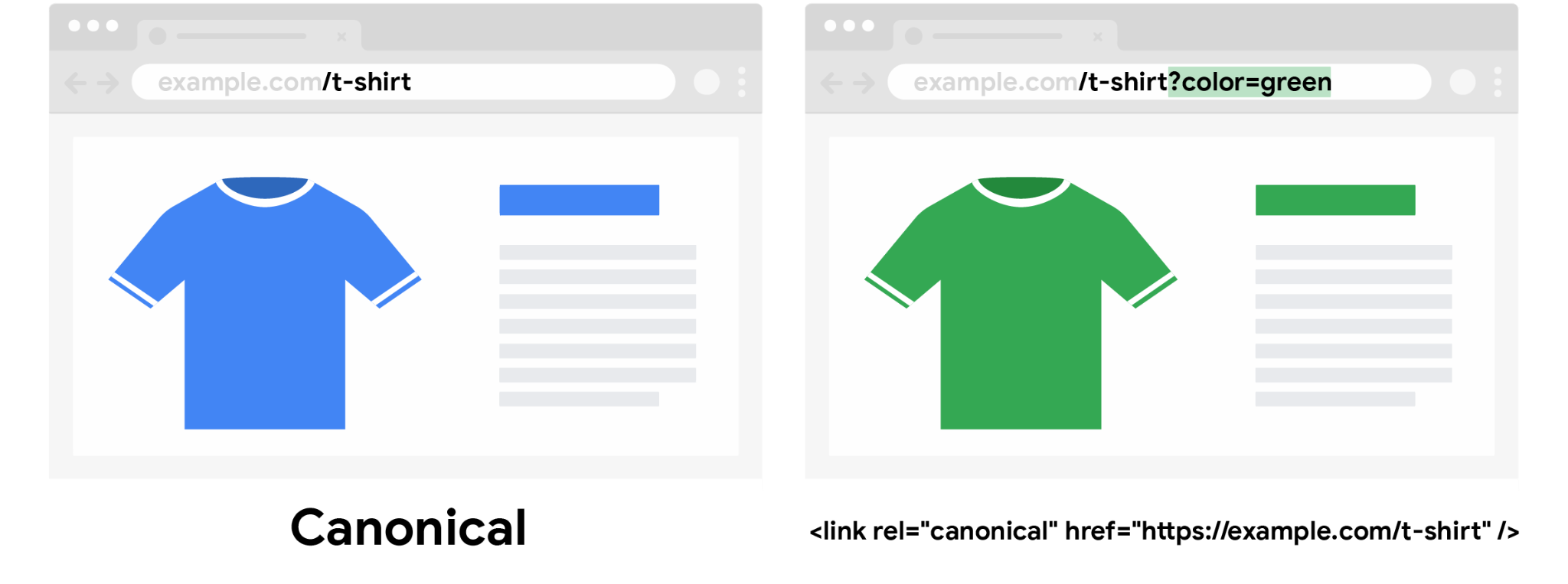Projektowanie struktury adresów URL na potrzeby witryn e-commerce
Dobrze zaprojektowane adresy URL pomagają Google efektywniej znajdować strony internetowe w Twojej witrynie e-commerce i je stamtąd pobierać. Jeśli masz wpływ na to, z czego składają się Twoje adresy URL (na przykład tworzysz własną witrynę od podstaw), ten przewodnik pomoże Ci dobrać ich strukturę tak, aby uniknąć problemów z indeksowaniem, na które Google natrafia w witrynach e-commerce.
Dlaczego struktura adresów URL ma znaczenie
Odpowiednio skonstruowane adresy URL ułatwiają Google skanowanie i indeksowanie witryny, a ich niedopracowana struktura może powodować następujące problemy:
-
Treści mogą zostać pominięte, jeśli Googlebot błędnie uzna, że 2 adresy URL zwrócą tę samą treść, ponieważ robot może pobrać tylko 1 URL (drugi zostanie odrzucony jako duplikat). Może się tak zdarzyć, jeśli do wyświetlania różnych treści są używane identyfikatory fragmentów (np.
#fragment). Podczas indeksowania Google nie korzysta z identyfikatorów fragmentów.Przykład: Google uzna
/product/t-shirt#blacki/product/t-shirt#whiteza tę samą stronę. -
Robot może pobrać te same treści kilka razy, jeśli uznamy, że 2 adresy URL są różne, choć w rzeczywistości zwracają tę samą stronę. Może to spowolnić indeksowanie witryny i niepotrzebnie obciążyć serwer WWW.
Przykład:
/product/black-t-shirti/product?sku=1234mogą zwracać tę samą stronę produktu, ale nie możemy tego stwierdzić na podstawie samego adresu URL. -
Robot może uznać, że witryna zawiera nieskończoną liczbę stron, jeśli adresy URL zawierają stale zmieniającą się wartość, np. sygnaturę czasową. Dlatego Google może potrzebować więcej czasu na znalezienie wszystkich przydatnych treści w Twojej witrynie.
Przykład: możemy potraktować
/about?now=12:34ami/about?now=12:35amjak różne adresy URL, choć oba wyświetlają tę samą stronę.
Więcej informacji o skanowaniu i indeksowaniu witryn przez Google znajdziesz w artykułach na temat tego, jak działa wyszukiwarka Google i jak roboty Google indeksują witryny.
Sprawdzone metody projektowania struktury adresów URL
Aby zoptymalizować sposób skanowania i indeksowania witryny przez Google, postępuj zgodnie z tymi sprawdzonymi metodami tworzenia struktury adresów URL.
Ogólne zalecenia dotyczące adresów URL
- Ogranicz liczbę alternatywnych adresów URL, które prowadzą do tych samych treści, abyśmy nie wysyłali do Twojej witryny nadmiernej liczby żądań. Google może się zorientować, że 2 adresy URL zwracają tę samą stronę dopiero po ich pobraniu.
- Jeśli serwer WWW nie rozróżnia wielkich i małych liter w adresie URL, zastosuj w całym tekście litery tej samej wielkości. Ułatwi to Google ustalenie, czy adresy URL wskazują tę samą stronę.
- Upewnij się, że w wynikach podzielonych na strony każda strona ma unikalny adres URL. Najwięcej błędów dotyczy tych adresów URL, których struktury podzielone są na strony.
-
Dodaj słowa opisowe w ścieżkach adresów URL. Mogą one ułatwić Google rozpoznanie zawartości strony.
Zalecane:
/product/black-t-shirt-with-a-white-collarNiezalecane:
/product/3243
Rekomendacje dotyczące parametrów zapytania w adresach URL
Przestrzegaj tych zaleceń dotyczących używania parametrów zapytania, aby ułatwić Google skanowanie i indeksowanie witryny.
-
W miarę możliwości używaj parametrów adresu URL
?key=valuezamiast?value. Umożliwiają one wyszukiwarce Google poznanie struktury witryny i zwiększają skuteczność skanowania oraz indeksowania.Zalecane:
/photo-frames?page=2,/t-shirt?color=greenNiezalecane:
/photo-frames?2,/t-shirt?green -
Unikaj stosowania tych samych parametrów dwukrotnie. W przeciwnym razie jedną z tych wartości Googlebot może zignorować.
Zalecane:
?type=candy,sweetNiezalecane:
?type=candy&type=sweet -
Unikaj wewnętrznych linków do parametrów tymczasowych, takich jak identyfikatory sesji, kody śledzenia, wartości zależne od użytkownika (
location=nearby,time=last-week) i bieżąca godzina. Stosowanie takich parametrów może prowadzić do powstawania adresów URL, które mają krótki czas działania, lub zduplikowanych adresów URL tej samej strony Aby uzyskać najlepsze wyniki w wyszukiwarce Google, używaj długoterminowych, trwałych adresów URL.Zalecane:
/t-shirt?location=UKNiezalecane:
/t-shirt?location=nearby,/t-shirt?current-time=12:02,/t-shirt?session=123123123
Jak Google interpretuje adresy URL dotyczące wariantów produktów
W przypadku witryn e-commerce trzeba dobrze przemyśleć strukturę adresów URL w sytuacji, gdy produkt jest dostępny w wielu rozmiarach lub kolorach. Każda kombinacja atrybutów produktu to wariant produktu. Aby pomóc Google zrozumieć warianty Twoich produktów, zadbaj o to, aby każdy z wariantów mógł być identyfikowany za pomocą osobnego adresu URL. Zalecamy stosowanie tych struktur adresów URL wariantów:
-
segmentu ścieżki, np.
/t-shirt/green -
lub parametru zapytania, np.
/t-shirt?color=green
Więcej informacji znajdziesz w dokumentacji uporządkowanych danych dotyczących wariantów produktu.
Jeśli do identyfikowania wariantów używasz opcjonalnych parametrów zapytania, jako kanoniczny URL wybierz adres z pominiętym parametrem zapytania. Ułatwi to Google zrozumienie zależności między wariantami produktu.

Używanie adresów URL w treści
Aby ułatwić wyszukiwarce Google i Zakupom Google prawidłowe identyfikowanie produktów oraz zależności między wariantami produktów, postępuj zgodnie z tymi sprawdzonymi metodami dotyczącymi używania adresów URL w treści.
-
Używaj tego samego adresu URL w linkach wewnętrznych, plikach mapy witryny i tagach
<link rel="canonical">. Jeśli na przykład tworzysz link do pierwszej strony w sekwencji podzielonej na strony za pomocą parametru zapytania, w którym stroną domyślną jest pierwsza strona, w całej witrynie w adresach URL uwzględnij parametr?page=1lub go z nich wyklucz. -
Użyj wskazującego na niego samego tagu
<link rel="canonical">(w którym adres URL w tagu wskazuje bieżącą stronę) na wszystkich stronach dostępnych do indeksowania i uwzględnij te adresy URL w pliku sitemap. -
W przypadku produktów z unikalnymi adresami URL dotyczącymi poszczególnych wariantów użyj tagu
<link rel="canonical">, aby umieścić kanoniczny adres URL produktu na wszystkich stronach wariantów. Więcej informacji znajdziesz w opisie właściwościcanonical_linkw Google Merchant Center. -
Dodawaj linki bezpośrednio na stronach za pomocą tagów
<a href>. Nie używaj JavaScriptu do przechodzenia między stronami. Googlebot może nie wykryć przejścia na podstawie kodu JavaScript. Więcej informacji o przetwarzaniu kodu JavaScript przez Google znajdziesz w artykule JavaScript a SEO – podstawy. -
Jeśli to możliwe, umieść znaczący tekst między tagami
<a href>i</a>, np. nazwę powiązanego produktu. Nie używaj wyrażeń ogólnych, takich jak „kliknij tutaj”. -
Nie twórz linków do stron bez przydatnych treści, a przynajmniej unikaj ich indeksowania. Jeśli kategoria nie zawiera żadnych elementów, użyjwartości
noindextagumetarobots. Jeśli witryna wykryje, że kategoria stała się pusta i usunie ją automatycznie z wyszukiwania w witrynie oraz z przeglądarki, rozważ w przypadku tej strony zwrócenie kodu stanu HTTP404 (not found).
Dodatkowe materiały
Chcesz dowiedzieć się więcej? Zapoznaj się z tymi zasobami:
